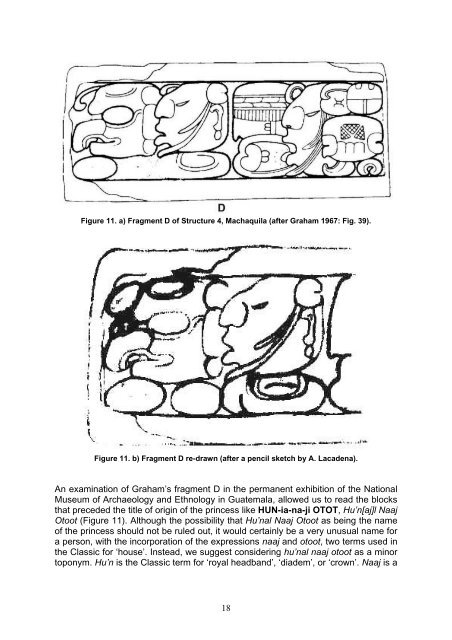63 an epigraphic account related to structure 4 at ... - Famsi
63 an epigraphic account related to structure 4 at ... - Famsi
63 an epigraphic account related to structure 4 at ... - Famsi
You also want an ePaper? Increase the reach of your titles
YUMPU automatically turns print PDFs into web optimized ePapers that Google loves.
Figure 11. a) Fragment D of Structure 4, Machaquila (after Graham 1967: Fig. 39).<br />
Figure 11. b) Fragment D re-drawn (after a pencil sketch by A. Lacadena).<br />
An examin<strong>at</strong>ion of Graham’s fragment D in the perm<strong>an</strong>ent exhibition of the N<strong>at</strong>ional<br />
Museum of Archaeology <strong>an</strong>d Ethnology in Gu<strong>at</strong>emala, allowed us <strong>to</strong> read the blocks<br />
th<strong>at</strong> preceded the title of origin of the princess like HUN-ia-na-ji OTOT, Hu’n[aj]l Naaj<br />
O<strong>to</strong>ot (Figure 11). Although the possibility th<strong>at</strong> Hu’nal Naaj O<strong>to</strong>ot as being the name<br />
of the princess should not be ruled out, it would certainly be a very unusual name for<br />
a person, with the incorpor<strong>at</strong>ion of the expressions naaj <strong>an</strong>d o<strong>to</strong>ot, two terms used in<br />
the Classic for ‘house’. Instead, we suggest considering hu’nal naaj o<strong>to</strong>ot as a minor<br />
<strong>to</strong>ponym. Hu’n is the Classic term for ‘royal headb<strong>an</strong>d’, ‘diadem’, or ‘crown’. Naaj is a<br />
18
















